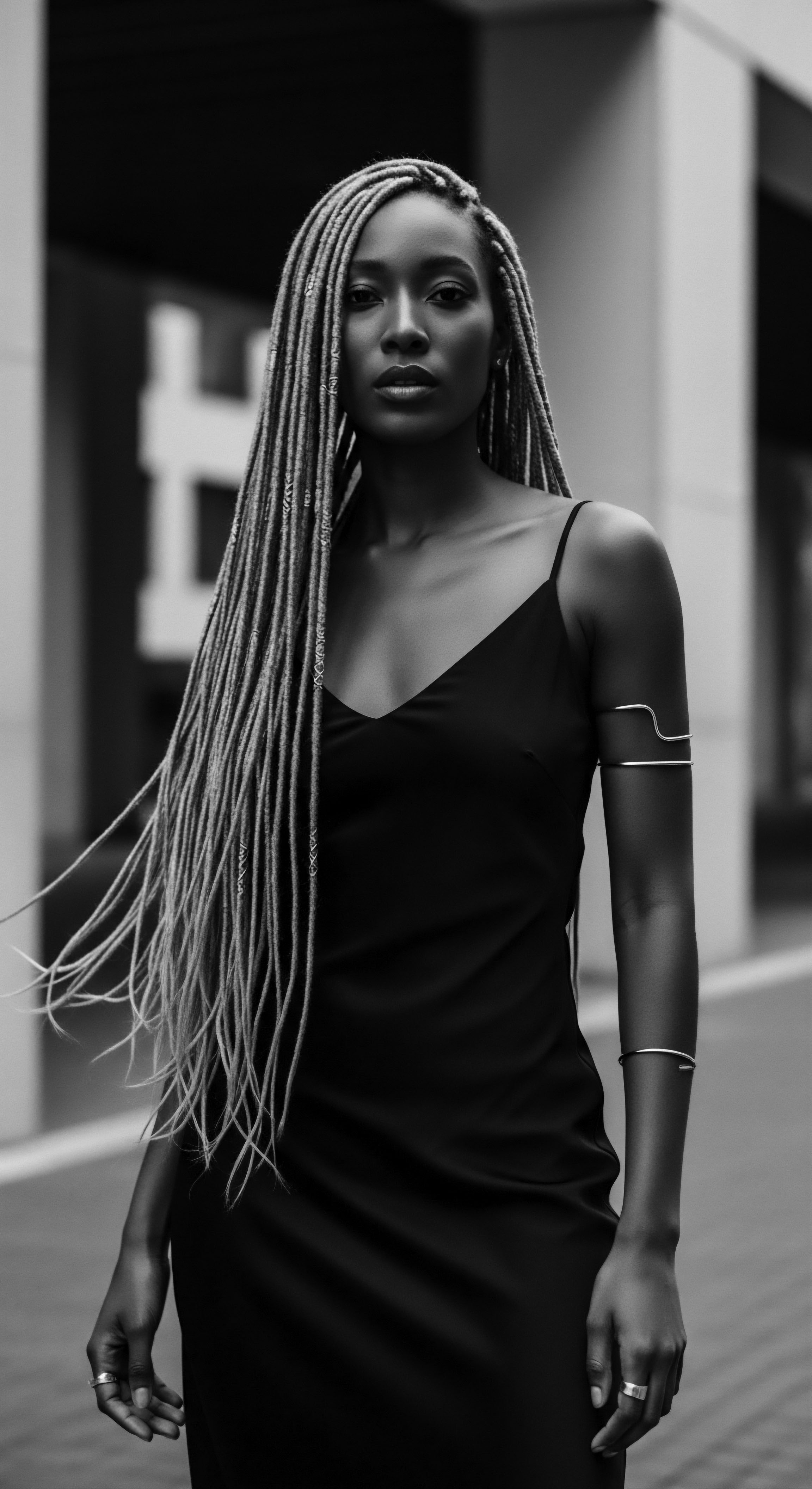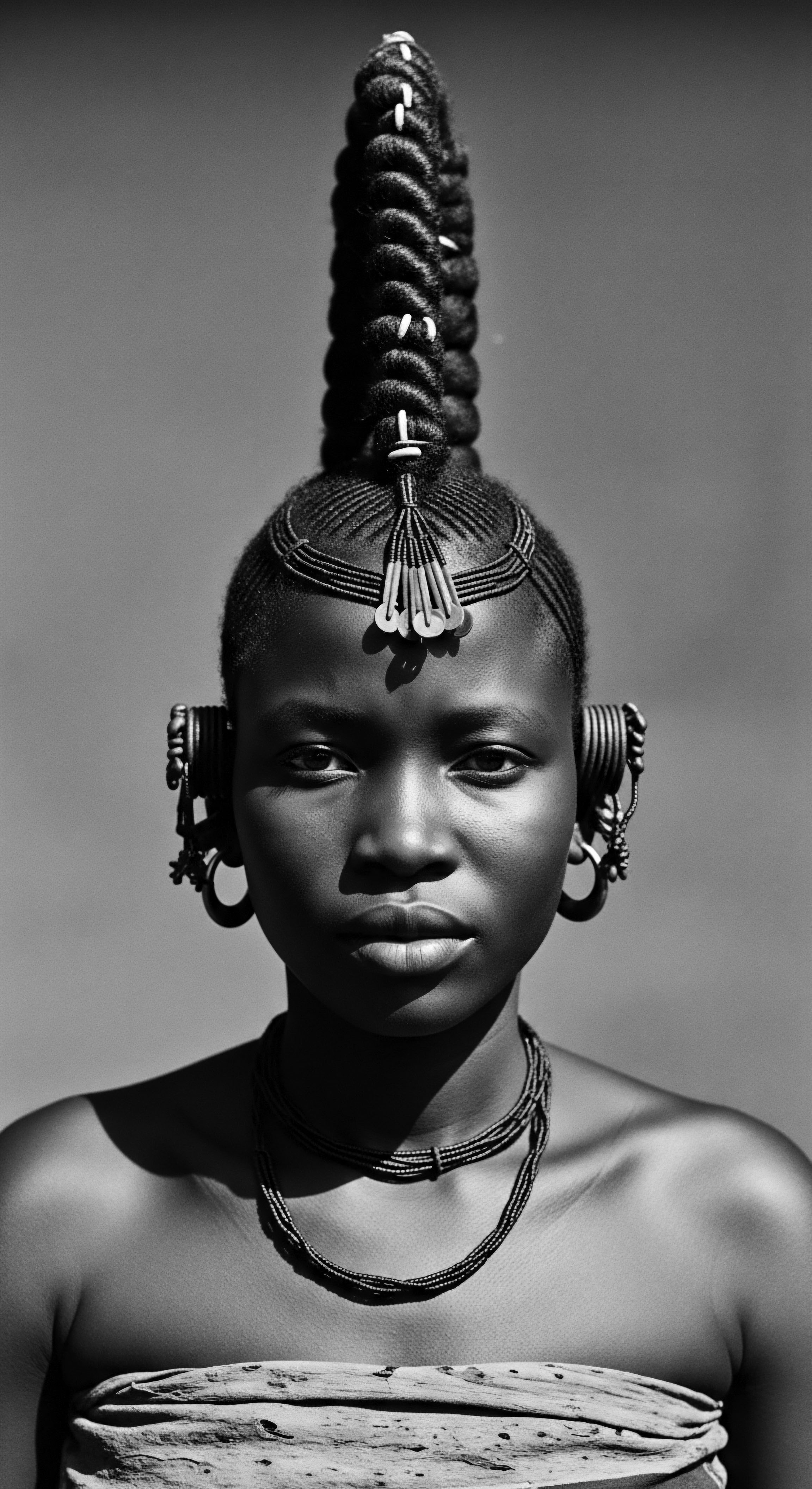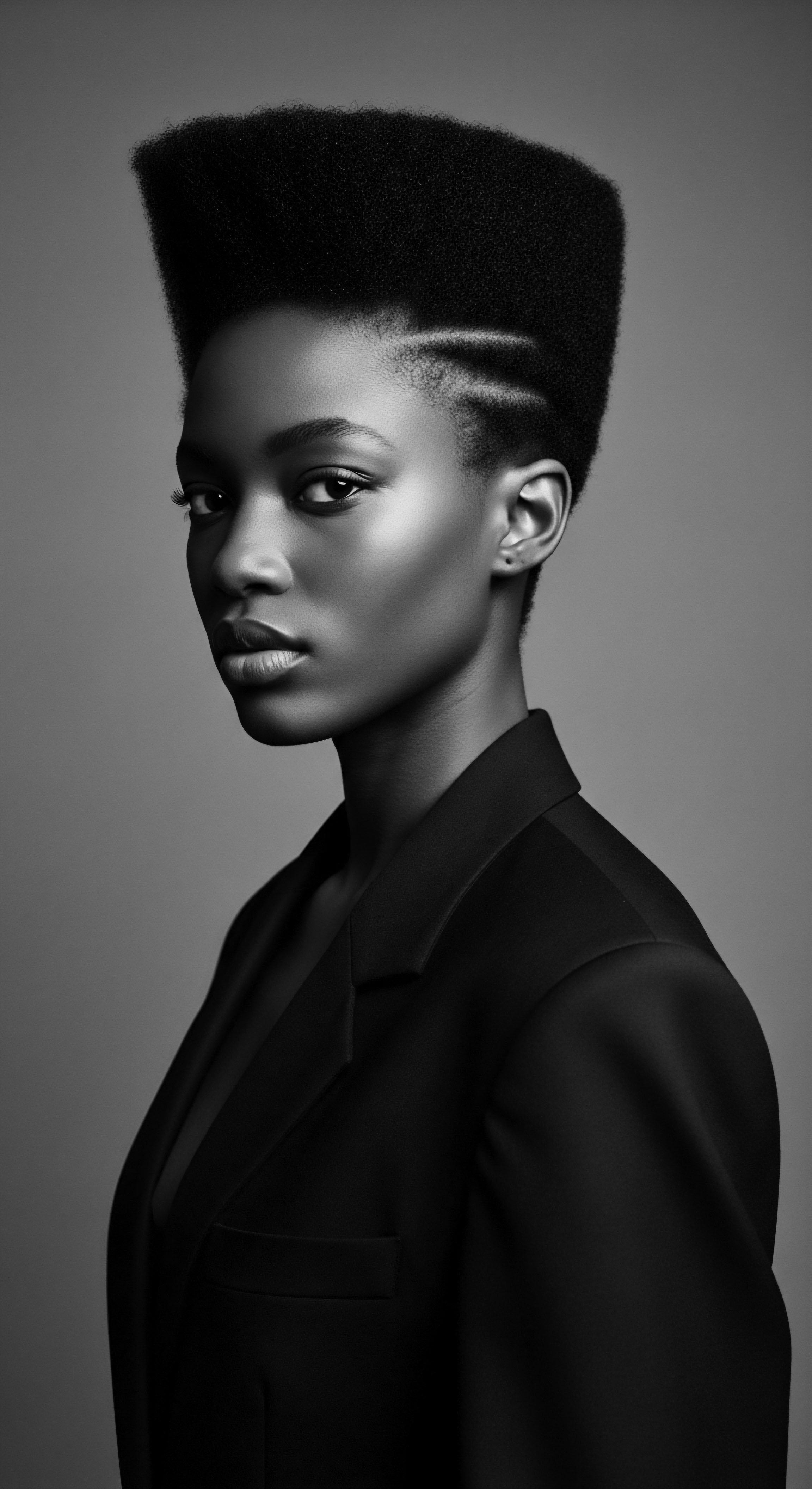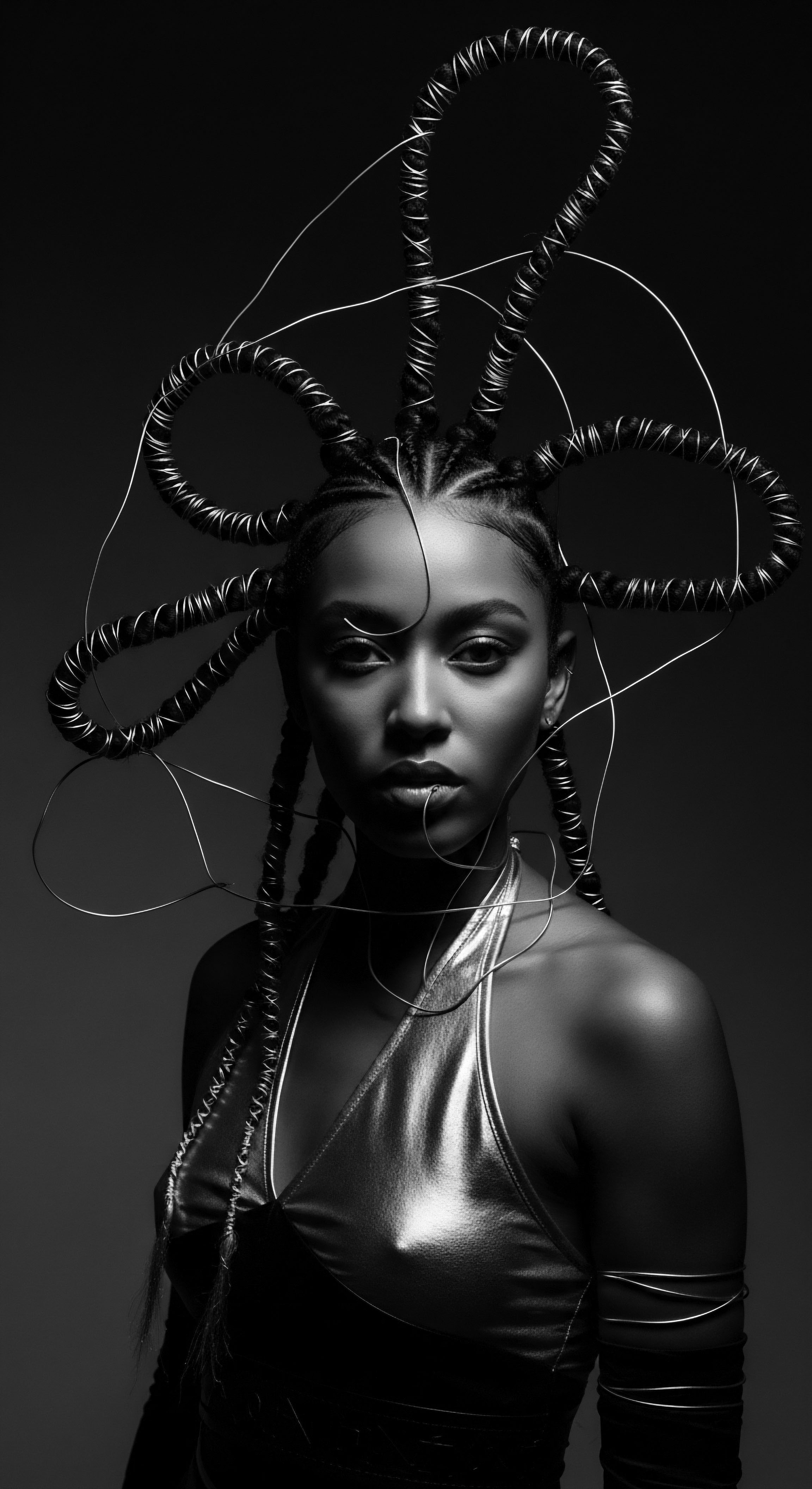
Roots
The whisper of hair, a soft rustle of strands, carries within it stories far older than our fleeting moments. For those with textured hair, this whisper often swells into a chorus, a deep, resonant hum of ancestry and collective memory. It is a profound meditation on how something so seemingly personal as the fibers emerging from our scalps can hold the very imprints of generations, shaping our understanding of self and our place in the world. The question of how historical hair practices continue to sculpt identity and community is a call to listen closely to these ancestral echoes, recognizing that the care we extend to our crowns today is but a continuation of ancient wisdom, a living testament to resilience and spirit.

Hair’s Elemental Blueprint
At its fundamental level, hair is an astonishing marvel of biological engineering, each strand a complex protein filament growing from a follicle nestled within the skin. For textured hair, this biological blueprint presents itself with particular distinctions. The follicle itself tends to be elliptical or flattened in cross-section, causing the hair shaft to grow in a curvilinear, often helical, pattern. This unique geometry, inherited across countless generations, dictates the varied coil patterns, from loose waves to tightly wound coils, that characterize Afro-textured hair.
The cuticle, the outermost protective layer, often features more lifted scales along these curves, which contributes to its singular beauty but also its distinct needs for moisture and gentle handling. Understanding this intrinsic nature, not as a deviation from a norm but as a magnificent adaptation, allows us to appreciate the ingenuity woven into every curl and coil.
The intrinsic helical pattern of textured hair is not a deviation, but a testament to profound biological adaptation, carrying ancestral imprints within its very structure.

An Ancestral Lexicon of Coils
The way we name and classify textured hair today, with systems like the Andre Walker typing method (though a subject of ongoing discussion in our communities), attempts to categorize these diverse helical expressions. Yet, long before contemporary classifications, ancestral communities possessed their own rich lexicons for describing hair’s myriad forms. These ancient terms, often rooted in specific cultural contexts, spoke not only to appearance but also to spirit, status, and lineage. Consider the nuanced understanding of hair types present in West African societies, where distinctions went beyond curl pattern to encompass how hair received blessings or protected against malevolent forces.
The language employed to describe hair was, and remains, a vital component of identity, an affirmation of shared heritage. The care rituals of our forebears often recognized the distinct requirements of each pattern, knowing instinctively what modern science has since come to confirm ❉ that different curl architectures benefit from particular approaches to nourishment and style retention.

Growth Cycles and Environmental Narratives
Hair growth follows a cycle of rest, growth, and shedding ❉ anagen, catagen, and telogen. While these biological phases are universal, the historical factors influencing them within Black and mixed-race communities are deeply significant. Ancestral diets, rich in nutrient-dense foods, played a substantial role in promoting strong hair growth. The consumption of ingredients like leafy greens, certain roots, and lean proteins, often indigenous to various African regions, provided the building blocks for resilient strands.
Moreover, living in climates where humidity was often a generous companion, hair was naturally imbibed with atmospheric moisture, reducing some of the dryness challenges faced by those in arid environments. This environmental relationship meant traditional care practices were often about working with, rather than against, nature’s provisions. The practice of using plant-derived oils and butters, as seen with the women of the Basara people and their reliance on chebe powder (Croton zambesicus, Mahllaba Soubiane, cloves, resin, and stone scent) to retain length and strength, speaks to a deep, experiential scientific understanding of how to protect the hair shaft from environmental stressors. This knowledge, passed down through the ages, underscores a continuum of care that bridges ancient wisdom with contemporary appreciation for ingredient efficacy.
- Anagen Phase ❉ This growth stage, lasting several years, is sustained by adequate nutrition and a healthy scalp. Ancestral diets provided the building blocks.
- Catagen Phase ❉ A transitional, short period where growth halts.
- Telogen Phase ❉ The resting stage, followed by shedding, is a natural part of renewal.

The Living Archive of Practices
In the expanse of history, before the fragmentation of communities, hair was a vibrant communication system. It relayed one’s lineage, social standing, age, marital status, and even spiritual affiliations. The practices associated with hair were not mere cosmetic acts; they were ceremonies of being. Consider the Mbalantu women residing near the southern tips of Angola and the northern border of Namibia.
Their practice of cultivating ankle-length hair, often referred to as “Eembuvi” braids, involves an intricate, ceremonial care routine passed through generations. Around the age of twelve, a girl’s hair begins specific treatments to encourage growth, involving a thick paste from the finely powdered tree bark of the “Omutyuula” tree mixed with fat. This unique blend ensures the hair remains moisturized and avoids breakage, allowing for extraordinary length retention. The hair styles then evolve with the woman’s life stages, from adolescence to marriage, each change marked by a ceremony, cementing identity and community ties. This ancestral adherence highlights hair as a living archive, each style a chapter, each strand a testament to a heritage preserved and cherished.
| Aspect of Hair Biology Hair Texture / Shape |
| Ancestral Understanding / Practice Recognized diverse patterns with cultural names; understood different needs. |
| Modern Scientific Link Variations in follicle shape (elliptical/flattened) lead to helical growth. |
| Aspect of Hair Biology Moisture Retention |
| Ancestral Understanding / Practice Applied natural oils, butters, and humectants (e.g. mucilage from plants). |
| Modern Scientific Link Science confirms lipid-rich ingredients and humectants seal in water, addressing lifted cuticles. |
| Aspect of Hair Biology Strength and Growth |
| Ancestral Understanding / Practice Utilized nutrient-rich diets and topical applications of plant extracts. |
| Modern Scientific Link Nutritional impact on keratin production; plant compounds providing antioxidants and anti-inflammatory benefits. |
| Aspect of Hair Biology Scalp Health |
| Ancestral Understanding / Practice Used clays and plant-based washes for cleansing without stripping. |
| Modern Scientific Link Clays draw impurities; plant saponins offer gentle cleansing, maintaining scalp microbiome. |
| Aspect of Hair Biology Our ancestral practices often held an intuitive grasp of hair biology, insights validated by contemporary scientific exploration. |

Ritual
The act of tending to textured hair transcends mere grooming; it transforms into a ritual, a deliberate engagement with our living heritage. These practices, honed over centuries, represent an art form, a science of touch and transformation that speaks volumes about individual and collective identity. From protective coiffures to methods of natural definition, each styling choice echoes a deep cultural memory, intertwining personal expression with the enduring spirit of community.

Protective Hairstyles and Their Deep Roots?
Protective hairstyles, such as braids, twists, and locs, are not contemporary inventions. Their roots stretch back through millennia, serving as vital tools for hair preservation, cultural expression, and social communication across African societies. Beyond their practical function of shielding fragile ends from environmental damage and reducing manipulation, these styles held profound symbolic weight. In many ancient African communities, the intricacy of a braid or the length of locs could signify a person’s age, marital status, tribal affiliation, wealth, or spiritual devotion.
During the horrific transatlantic slave trade, when deliberate attempts were made to strip enslaved Africans of their identity by shaving heads, these very styles became clandestine maps to freedom, carrying seeds for survival, and silent acts of resistance. The geometric patterns of cornrows, for instance, were reportedly used to convey escape routes, with different lines and curves indicating paths and meeting points. The endurance of these styles today, far from their origins, stands as a powerful continuation of ancestral ingenuity and defiant spirit.
Protective styles, born of necessity and artistry, became profound acts of preservation, communication, and resistance throughout history.

Natural Styling and Ancestral Methods?
Defining natural texture is a practice that draws heavily on traditional methods of care. Ancient African communities used a wealth of natural ingredients to hydrate, condition, and set their hair. The Chebe powder ritual of the Basara women of Chad, mentioned earlier, involves applying a mixture of specific plants and oils to damp hair, then braiding it, allowing the paste to remain for days. This method, passed down through matrilineal lines, is credited with exceptional length retention and healthy, robust strands.
Similarly, the use of various plant oils—from shea butter in West Africa to marula oil in Southern Africa, or even ghee in Ethiopian communities—underscores a deep, intuitive understanding of emollients and their ability to seal moisture within the hair shaft. These aren’t merely historical curiosities; they are living traditions, informing contemporary natural hair regimens that prioritize holistic health over fleeting aesthetics. The communal aspect of these styling sessions, often taking place under the shade of a tree or within family compounds, served as spaces for intergenerational knowledge transfer, storytelling, and bonding, solidifying community ties through shared beauty rituals.

The Tools of Tradition and Transformation
The implements used in textured hair care tell their own story, evolving from simple, natural materials to more complex devices. Historically, hands were the primary tools, adept at finger-combing, twisting, and braiding. Combs, carved from wood or bone, were often not just functional but also symbolic, possessing spiritual significance or indicating social status. In some ancient West African cultures, the Afro comb served as a status symbol, a decorative piece, and a tool.
The development of tools like the hot comb, popularized by innovators like Madam C.J. Walker in the late 19th and early 20th centuries, represents a complex chapter. While offering a means to achieve straightened styles, often driven by societal pressures to conform to Eurocentric beauty standards, these tools also provided economic empowerment for Black women. The story of hair tools, then, is not straightforward. It reflects both the ancestral embrace of natural textures and the adaptive strategies developed in response to colonial beauty ideals.
- Wooden Combs ❉ These tools, often crafted with wide teeth, provided gentle detangling for tightly coiled hair, preserving the integrity of the strands.
- Hair Picks ❉ Beyond their utility in fluffing and shaping, picks, especially the iconic Afro pick, became symbols of Black pride and identity during the Civil Rights era.
- Boning Tools ❉ In some cultures, specific tools were used to sculpt and smooth intricate updos, applying pressure and natural pomades for lasting hold.

Relay
The wisdom of historical hair practices is not confined to dusty archives; it pulses as a vibrant relay, transmitting ancestral knowledge into contemporary care. This continuity is especially evident in the holistic approach to textured hair health, the deliberate nighttime rituals, and the solutions sought for hair challenges, all deeply rooted in a legacy of understanding and adaptation. The very act of caring for textured hair today is an affirmation of a profound, enduring heritage.

The Regimen as a Bridge to Ancestry?
Crafting a personalized hair regimen is a dialogue between modern science and the echoes of ancestral wisdom. Our ancestors, lacking chemical laboratories, were astute observers of nature, discerning the properties of plants, oils, and minerals that nurtured their hair. Their regimens were often intuitively holistic, recognizing the interplay between internal wellness and external hair vitality. The use of traditional ingredients, many now celebrated in modern formulations, speaks to this deep understanding.
Take, for instance, shea butter, long a staple across West Africa, valued for its emollient properties that seal in moisture and protect the hair shaft. Its continued prominence in textured hair products today is a testament to its enduring efficacy, a legacy passed through generations. Other elements, like fermented rice water, a practice well-documented among the Yao women of Huangluo Village in China, have found renewed interest for their potential to strengthen hair and promote growth, a secret held for over two millennia. This relay of knowledge is not simply about ingredients; it concerns the principles of gentle handling, consistent moisture, and protective styling that remain cornerstones of healthy textured hair care.

Nighttime Sanctuaries and Bonnet Wisdom?
The practice of protecting hair at night, now a widely accepted tenet of textured hair care, has deep historical precedence. Ancestral communities, particularly across Africa, understood the importance of safeguarding hair from environmental aggressors, including friction during sleep. Headwraps and coverings were not solely for daytime adornment; they served a crucial practical purpose, preserving intricate styles, retaining moisture, and preventing tangles. The bonnet, in its various forms, stands as a direct descendant of these traditional coverings.
It shields delicate strands from the abrasive nature of cotton pillowcases, which can absorb moisture and create frizz. This nightly ritual is more than a preventive measure; it is a quiet, deliberate act of reverence for the hair, an extension of the day’s care into the quiet hours. This consistent protection minimizes breakage, allowing hair to retain length and health, a wisdom passed down through the intimate spaces of the home, from elder to younger generations.

Traditional Solutions for Persistent Challenges
Hair challenges are not new; they are as old as hair itself. From dryness to breakage, ancestral communities developed ingenious, localized solutions that continue to resonate. The Basara women of Chad, as noted, utilize chebe powder not only for length retention but also to combat breakage, by providing a protective coating and sealing in moisture. Beyond topical applications, a holistic view often informed problem-solving.
Issues of thinning or sluggish growth were addressed through dietary adjustments, incorporating herbs known for their fortifying properties, or engaging in scalp massages to stimulate circulation—a practice with roots in many traditional healing systems. The understanding that hair health reflects overall wellness is a heritage deeply embedded in many African philosophies. For example, traditional African black soap, made from plantain skins, cocoa pods, and shea butter, provides a gentle yet effective cleanse that honors the hair’s need for moisture, contrasting sharply with harsher modern sulfates that strip natural oils. The continued use of these time-tested solutions speaks to their efficacy and the enduring power of inherited wisdom in navigating the unique needs of textured hair.
The impact of historical hair practices extends beyond individual care, touching the very fabric of community. The shared experience of hair discrimination, rooted in colonial ideologies that devalued textured hair as “unruly” or “unprofessional,” forged bonds of solidarity and resistance. A 2020 study by Duke University found that Black women with natural hairstyles were perceived as less professional and less competent, and were less likely to be recommended for job interviews than candidates with straight hair.
This enduring bias, a direct lineage from centuries of systemic oppression and the “Comb Test” or “Pencil Test” of the past, illustrates how historical perceptions continue to shape contemporary experiences. Yet, this shared burden has simultaneously strengthened community, prompting movements like the Natural Hair Movement to reclaim and celebrate ancestral styles as powerful affirmations of identity, heritage, and collective pride.

Reflection
The narrative of textured hair is a living saga, each strand a testament to survival, creativity, and the unwavering spirit of heritage. From the elemental biology that shapes its unique helix to the intricate rituals of care passed through generations, hair serves as a profound connector—linking us to our ancestors, to community, and to a deeply rooted sense of self. The historical practices, born of necessity, artistry, and spiritual conviction, are not relics of a distant past.
Instead, they manifest in every twist, every braid, every intentional application of a nourishing balm today. They guide our hands as we tend to our crowns, reminding us that this care is a sacred act, a continuation of a legacy that has endured hardship and celebrated beauty against all odds.
This journey through the story of textured hair, particularly Black and mixed-race hair, reveals how deeply our identity and community are shaped by practices that transcend time. It speaks to a wisdom that understood the power residing within each curl, each coil, seeing hair not as a mere adornment but as a vibrant repository of history, resilience, and cultural memory. The care we give our strands today is a dialogue with those who came before us, a quiet rebellion against historical attempts to diminish our crowns, and a joyous affirmation of who we are. It underscores the enduring truth that the soul of a strand carries the whispers of our collective past, guiding us towards a future where every texture is revered, every heritage celebrated, and every crown worn with boundless pride.

References
- Byrd, Ayana, and Lori L. Tharps. Hair Story ❉ Untangling the Roots of Black Hair in America. St. Martin’s Griffin, 2014.
- Dawson, Ashley, et al. “The Cost of Curls ❉ Discrimination, Social Stigma, and Identity Oppression of Black Women Through Their Hair.” W&M ScholarWorks, 2019.
- Grewal, Inderpal, and Caren Kaplan. Gender, Race, and Nation ❉ A Reader. Blackwell Publishing, 2001.
- Mercer, Kobena. Welcome to the Jungle ❉ New Positions in Black Cultural Studies. Routledge, 1994.
- Patton, Tracey Owens. African-American Hair ❉ An Analytical Study of the Culture. University Press of Mississippi, 2006.
- Thompson, Marilyn. “The Black Woman’s Hair ❉ The Politics of Hair Texture and the Social Construction of Race.” Journal of Black Studies, vol. 39, no. 5, 2009, pp. 827-843.
- Walker, Madam C.J. Madam C.J. Walker’s Hair Culture. P. Blakiston’s Son & Co. 1916.
- Wilkerson, Isabel. The Warmth of Other Suns ❉ The Epic Story of America’s Great Migration. Random House, 2010.
